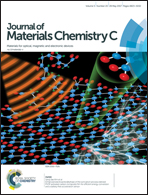Detection of glutaraldehyde in aqueous environments based on fluorescence quenching of a conjugated polymer with pendant protonated primary amino groups†
Abstract
With the aim of detecting glutaraldehyde (GA) in wastewater released from hospitals and other sites, fluorescent poly(phenyleneethynylene) with pendant protonated primary amino groups (PPE-NH3+) was synthesized and characterized. The fluorescence of the conjugated polyelectrolyte PPE-NH3+ in aqueous solution changed upon addition of aldehydes. Among many commonly encountered aldehydes including formaldehyde (FA) and glutaraldehyde (GA), GA displayed the strongest quenching of the fluorescence of PPE-NH3+. The quenching efficiency reached above 85% with 1 mM of GA and the limit of detection (LOD) was 0.49 μM. The fluorescence quenching mechanism was discussed. GA, as a dialdehyde, could react with amino groups on different polymer chains simultaneously, and thus might result in more efficient chain aggregation and quenching. Finally, this sensory system was demonstrated to be very effective in detecting GA in real water samples from a water tap in our lab, a pond on the campus, Dushu lake and a river nearby a hospital.



 Please wait while we load your content...
Please wait while we load your content...